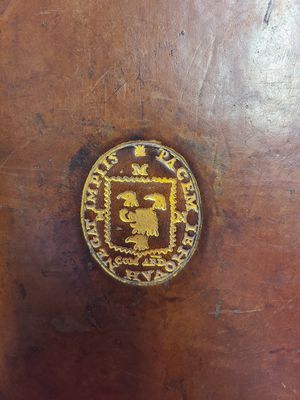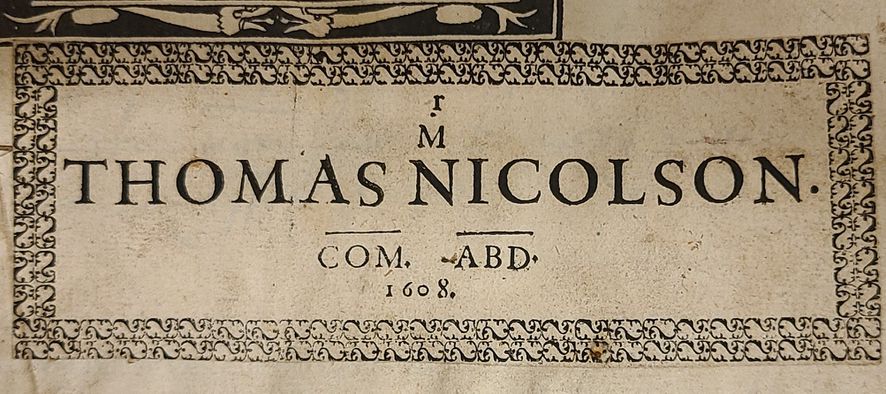Thomas Nicolson d.1625
_NOTITLE__
Thomas NICOLSON d.1625
Biographical Note
Thomas Nicolson was the son of James Nicolson, a public notary and clerk to the signet, and Elizabeth Henderson. His father James was originally from Aberdeen, but established himself in Edinburgh in the 1560s. His brother was John Nicolson, a commissary of Edinburgh in 1584, and an advocate in the court of session from around 1586. According to research by Adeyln Wilson, Thomas likely graduated from the University of Glasgow in 1585. In 1594, he was admitted as an advocate to the Court of Session in Edinburgh. He later relocated to Aberdeen, where he was a judge (also known as a commissary) in the local commissary court from at least 1604, a position which he held for around twenty years.
In 1619, Nicolson was appointed as commissioner for the reintroduction of legal education to King’s College, Aberdeen, which had previously been abolished during post-reformation educational reforms. He was subsequently named as “civilist” of King’s College, a position which made him the master of civil law at the university, though, as Wilson points out, it is unclear whether Nicolson did any teaching. In 1621 he purchased the estate of Cockburnspath near Edinburgh. After his death in 1625, his son James inherited the estate.
Books
Nicolson’s library appears to have been dispersed immediately after his death. The inventory of Nicolson’s property on his death records that his library was worth 2000 merks, though specific titles are not listed, and thus the full extent of his library is unknown. Surviving volumes cover subjects such as law, history and classical authors, several of which are in Greek.
Wilson notes that most of Nicolson’s law books were by jurists associated with Italian commentators which would have provided Nicolson with “the forensic, practical legal education of the so-called mos italicus, which was used in legal practice throughout Europe" (Wilson, p.117).
Examples from Nicolson's library include:
Homer's Ilias kai Odysseia meta tēs exēgēsios... (Basel, 1535) (NLS K.4.a.[2]), previously owned by numerous members of the Sinclair family, including Henry Sinclair 1507/8-1565. Henry Sinclair's provenance features in many volumes owned by Nicolson, including an edition of Sophocles (Paris, 1553), gifted to Thomas by his brother John (NLS Bdg.m.108(1)).
An edition of Pliny the Elder's Historiæ mundi (Frankfurt am Main, 1599) (Royal Botanic Garden Edinburgh Folio P.2)
A sammelband of three medical works, including Rembert Dodoens (1517-1585) Medicinalium obseruationum exempla rara and George Bertinus De Consaltationibus medicorum et methodica febrium curatione commentarius (Basel, 1586) (Edinburgh University Library H 23.50/3).
De legibus connubialibus, et iure maritali (Lyon, 1560) by the French Jurist and leading legal humanist André Tiraqueau, in which he argued that the inferiority of women in law was justified (National Art Library Clements Collection CLE Drawer 7)
Gordon E Duff notes that Nicolson’s father James was also a book collector, although research undertaken for this article could only identify one surviving book from his library. This was Beza Tractationes Theologicae (Geneva, 1573), later owned by Thomas, and now in the library of Glamis Castle.
Characteristic Markings
Nicolson used three printed book labels, one undated and the others dated 1608 and 1610. With the exception of the date, each label reads “Mr Thomas Nicolson com. 1610. ABD.” and is surrounded by a border of type. He is thought to be the first Scot to regularly use a printed book label. Nicolson also inscribed his books with his name and his motto Pacem Iehovah negat impiis. Two armorial binding stamps are associated with Nicolson, both of which include his motto, his initials "M.T.N" and a lion's head erased between three hawks heads. However, W.S Mitchell believes that the second stamp belonged to his son Sir Thomas Nicolson (1609-1656), though several of the books which used this stamp also have Thomas Nicolson senoir's book label.
Printed book-label "Com. 1610. ABD".
Sources
- British Armorial Bindings
- Duff, E Gordon. ‘Early Scottish Book-bindings’ The Scottish Historical Review, Vol. 4, No. 16 (Jul., 1907), pp. 430-442
- Wilson, Adelyn. 'Legal practice and legal institutions in seventeenth century Aberdeen, as
witnessed in the lives of Thomas Nicolson of Cockburnspath and his associates' Journal of Irish and Scottish Studies vol. 9 , no. 2 (2018), pp. 93-128 93-128


